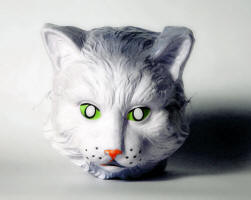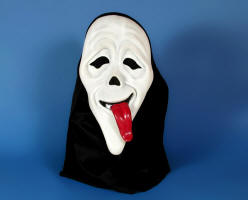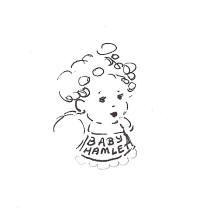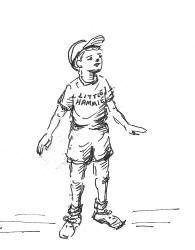|
CHAPTER
SIX:
1. Human action
Theatre is brought to life by human action. Human action is best described by a series of metaphors. It is like a wind that blows, not through space, but through time, propelling human events towards a conclusion. It is not a mechanical forces such as operates in dance (though it can sometimes produce the same consequences as a mechanical force), it is a force arising from human will, emotion and need. While affecting each character differently, it remains beyond individuality. It plays itself out through time. Space must be in a primitive and receptive state to give adequate voice and resonance to action’s passage through it.
The wind, though invisible, is seen and heard in the quivering of the leaves on the stems. It is heard by how it is resisted. Human action is perceptible because of the resistance to it by the human characters who try to remain anchored in spite of it.
It only abates when, like water on a mountain, which regardless of obstacles must work its way irrevocably down to the sea, it has reached its conclusion. The route they both take depends on the local terrain: spatially or in terms of human dynamics. That which is affected in the process may sometimes be changed for good, sometimes for ill, sometimes neither way, but often it is often propelled beyond the norms of its previous experience.
2. Time is the primary dimension of human action
Although it produces noticeable effects in space, human action works itself out primarily through time. It is within time that the force arises, is resisted or succumbed to, resolves, and passes away. It does not matter on an essential level whether the action occurs in France or Spain, indoors or outdoors. It matters more at what time it occurs: during peace, war, plenty or famine.
3. At this point on the spectrum, space is still in an early stage
As space
in dance becomes charged by the motion of the dancer, so does space in
theater by the passage of human action. Space as a whole gives action
resonance, just as does the space of the sound box of a violin to the
vibration of the strings. For something to resonate strongly it should
be basically hollow, i.e. in a primitive state. Later, with
architecture, space will again be hollow, but this time, it will be
space holding space, and not space holding within it action. Actors act
like individual lenses that focus and re-focus the action into space.
4. The ambiguous role of words
While words are essential to poetry, in theatre they play an ambiguous but unique role. On the one hand they are not a necessity: theatre can occur wordlessly, or with very few words. Often, though, they play a large role. When characters resist the wind of change brought upon by the action, they often resist by trying to understand what is happening to them. This understanding or delaying of the action can be heard as words. It is like a reed resisting the force of the wind, which vibrates thereby and gives forth a sound.
5. The intuition of action through sympathy and empathy
When going from animation to dance, there was a shift in emphasis from change of form to motion. From dance to theatre there is a similar shift in emphasis, this time from motion to e-motion. In dance the space which intercalates itself between us and the dancer is nullified through our intuitive experience of motion of the dancers. In theatre this space is also nullified, but through sympathy and empathy with the characters.
6. Time is the escapement which prevents the instant unwinding of action
Action requires time. To exist it must be born into time. It can only unroll through time. It can only end in time, for what is born in time perishes in time. Though its passage is perceptible by its manifestations in space, action itself is invisible and acts blindly. It becomes visible in space by the flame of its combustion in time. Philosophically, time itself is created by the demand of action to have a modality in which to work itself out. This literally “takes time” so that once born in time the action cannot unwind instantaneously.
The action cannot enter time until a set of initiating circumstances occur. Once that happens, though, a process is begun whereby the action’s potential energy is gradually converted to kinetic energy. However, if Hamlet finds out on Friday at 6 PM that Claudius murdered his father and kills Claudius at 6:10, though the action will have reached its destination in the most geodesic way, the play will never have happened. Human action does not usually unwind instantaneously; time acts as a delayer. In tragedy this unwinding is often accompanied by a diminution of choice, while the opposite is often true of comedy.
7. The past of the character: a new flow of time
In theatre, for the first time on the spectrum, there is an entity, the human character, which in its functioning with the work, has a past tense independent of our own initial experience of him.
At the moment the drama begins the possibility exists to gain access to the historical past of a character within the present in the play. This creates a wider past than in the previous arts. Just as importantly, it begins a process on the spectrum by which the flow of time becomes divided and weakened.
8. Effects in theatre which relate to time
The order of events is crucial to how a play evolves in time: “If only she had known earlier”. Later, when space gains ascendancy over time on the spectrum, the order in which things are experienced will have little impact on our experience of the work. Up until now the rate at which information is transmitted both within the work (for example from a dancer to another dancer) and from the work to us, is virtually instantaneous and limited only by physical cause and effect. With theatre, this process is often delayed by human resistance and motive. This again is a weakening of time, one often influenced by space (the messenger, in spite of his critical information, has to wait for the next ship to leave from Britain to France).
Part of the art of mapmaking is to find a way to reveal pertinent information that otherwise might be lost in a maze of detail. The playwright does the same. The details that ordinarily fill our everyday lives, but which would digress from a plot, are omitted. We do not watch Hamlet eating dinner after considering whether “To be or not to be”, then sending out his laundry and preparing for bed. In the other arts so far, what may have been omitted in order to gain intensity or relevance is unknowable to us. With theatre, where the subject is now human, there is a predictable series of events that we know ought to fill any character’s time. We can deduce that certain periods of time have been left out. Once again, there is a weakening to the flow of time. These absences are not yet too serious in theatre. We only need to be brought up to date in the next scene, much like turning on the morning news after a night’s rest, and updating our own consciousness to know that we are a continuation of the person who went to sleep. Regardless, historical time inside the work now flows differently than the time of our experience of the work. The next scene may take place at the same time as the previous scene, moments afterwards, or years afterwards. The iris of artistic time dilates and contracts relative to the historic time.
A growing power of space over time is noticeable, especially in scenes where there is action taking place on both sides of the stage, but each side representing a locale meant to be invisible to the other. In such a case, we do not know whether what is said in one of these locations is meant to occur before, during or after what was last said at the other location. Historical time and experienced could be in conflict.
9. Space offers a mean between apathy and risk
For the first time on the spectrum proximity in space can be a danger. If too close to a human action, we become part of it and suffer its consequences for ill or good. With dance, we might have at most bumped into a dancer. On the other hand, if we are too far away, we barely note what is happening on stage. A little closer we may note it but feel apathy. Space provides a choice of distance to affect a balance between safety and involvement: we can look into the face of the Gorgon but not turn to stone.
"Download full text of chapter"
|





